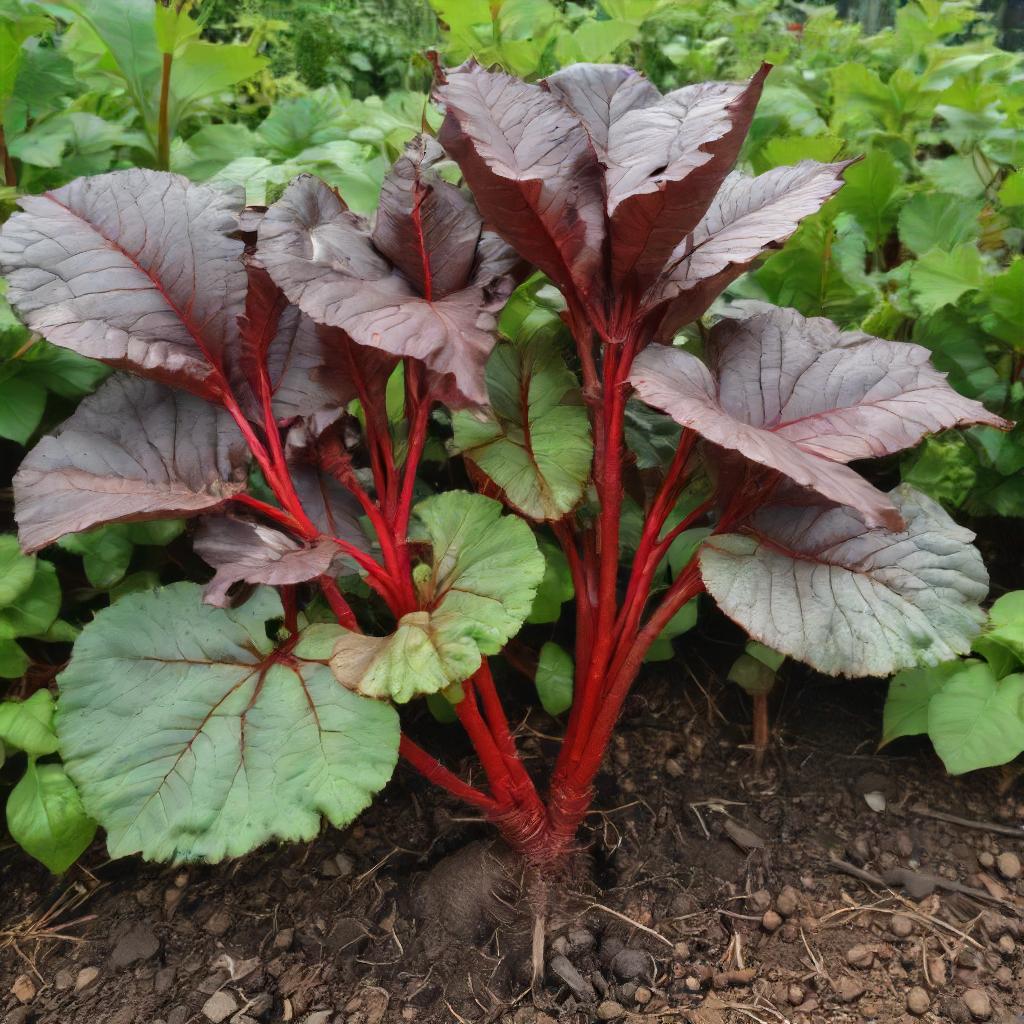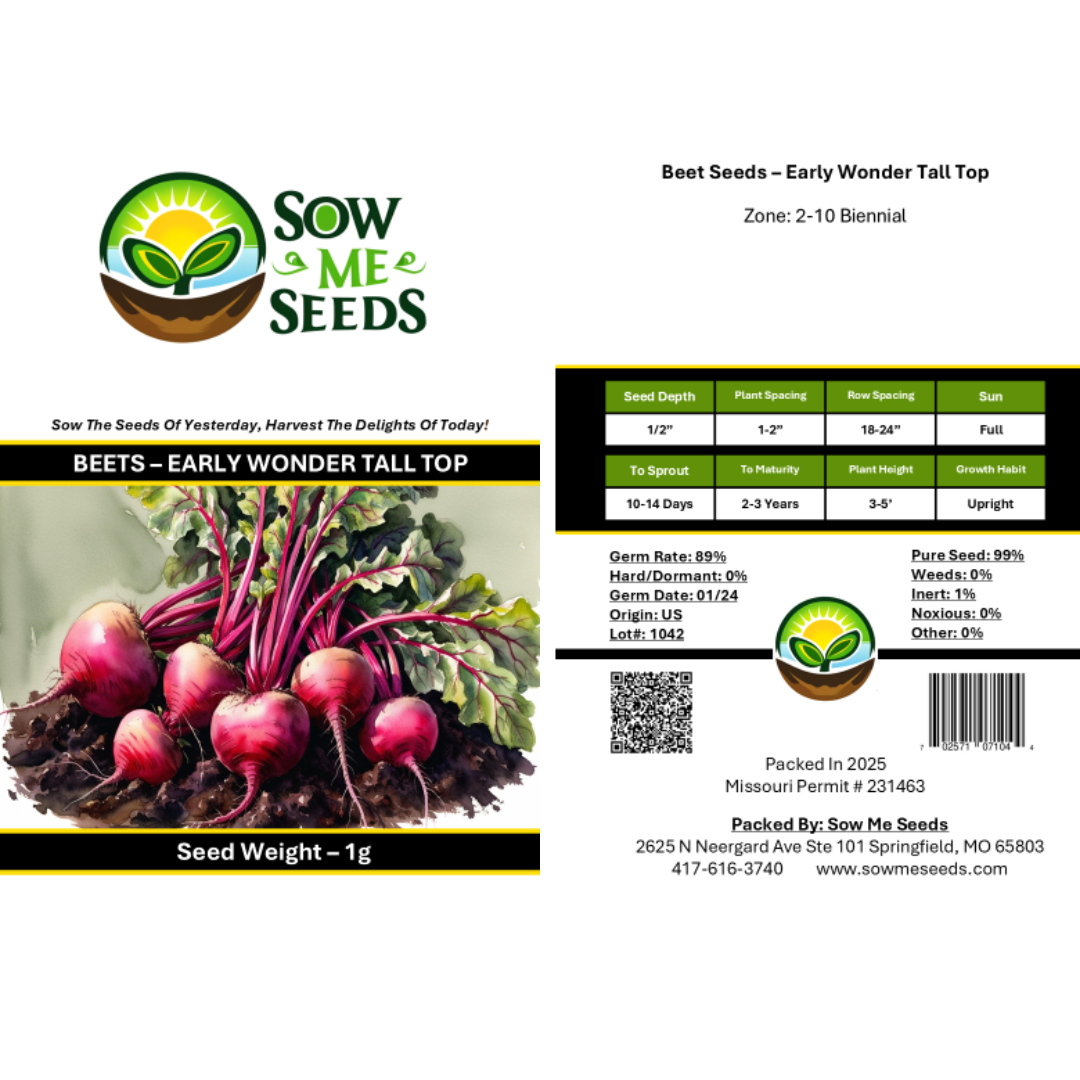- Hardiness Zone: 2-10 Biennial, Typically Grown As An Annual
Seed Depth: 1/2 inch
Seed Spacing: 1–2 inches
Row Spacing: 12–18 inches
Sunlight: Full sun to partial shade
Days to Sprout: 5–10 days
Days to Maturity: 50–60 days
Growth Habit: Upright, bushy annual
Sunlight: Thrives in full sun but tolerates partial shade, especially in warmer climates.
Soil Type: Prefers loose, well-drained soil with a pH of 6.0–7.5, free of rocks and debris to ensure uniform root development.
When to Plant: Sow seeds directly outdoors 2–4 weeks before the last frost in spring or 6–8 weeks before the first frost in fall.
Direct Sowing: Plant seeds 1/2 inch deep and 1–2 inches apart in rows 12–18 inches apart. Thin seedlings to 3–4 inches apart for optimal growth.
Indoor Sowing: Not recommended; direct sowing is preferred for root crops.
Succession Planting: Sow every 2–3 weeks for a continuous harvest throughout the season.
Watering: Water deeply and consistently, keeping the soil evenly moist to promote tender roots. Avoid overwatering to prevent splitting.
Fertilizing: Apply a balanced fertilizer or compost at planting and mid-season if needed to encourage root and foliage growth.
Pruning: No pruning necessary; beet greens can be harvested sparingly without affecting root development.
Pest and Disease Control: Monitor for leaf miners and fungal diseases; treat with organic solutions as needed.
When to Harvest: Harvest roots when they are 2–3 inches in diameter for the best texture and flavor, typically 50–60 days after planting. Greens can be harvested earlier for fresh use.
How to Harvest: Loosen the soil around the roots with a garden fork and gently pull beets from the ground. Avoid damaging roots during harvest.
Seed Collection: Allow some plants to bolt and flower. Collect seeds when pods are dry and mature.
Storing Seeds: Dry seeds thoroughly and store them in an airtight container in a cool, dry place.
Why You’ll Love It
Early Harvest: One of the first beets ready in spring — matures quickly for fast rewards.
Dual-Purpose Crop: Enjoy both the sweet, round roots and the tall, nutritious greens.
Adaptable: Performs well in a variety of soils and climates — great for succession planting.
Flavorful and Versatile: Roots have a mild, sweet flavor while the tops are excellent cooked or raw.
Plant Characteristics
Height: 12–18 inches (tops)
Growth Habit: Upright leafy greens with round, uniform roots
Root Type: Smooth, deep red globes with bright green tops and red stems
Days to Maturity: 45–60 days
Hardiness: Cool-season biennial grown as an annual
Flavor and Culinary Uses
Flavor: Roots are sweet and earthy; greens are tender with a slight spinach-like flavor
Culinary Uses: Roast or boil the roots, sauté or steam the greens — both are excellent in salads, soups, and stir-fries
Companion Planting Tips
Good Companions: Onions, lettuce, bush beans, and radishes
Avoid Planting Near: Pole beans (may interfere with growth)
Bonus Benefit: Excellent for early spring gardens and containers — makes the most of small spaces
Common Issues and Solutions
Pithy or Woody Roots: Harvest on time and water consistently for the best texture
Leaf Spot or Mildew: Improve airflow and avoid overhead watering — remove affected leaves
Poor Germination: Soak seeds overnight and keep soil moist during sprouting
Seeds Per Packet
| 3g | Approximately 132 |
| 10g | Approximately 440 |
Why You’ll Love It
Early Harvest: One of the first beets ready in spring — matures quickly for fast rewards.
Dual-Purpose Crop: Enjoy both the sweet, round roots and the tall, nutritious greens.
Adaptable: Performs well in a variety of soils and climates — great for succession planting.
Flavorful and Versatile: Roots have a mild, sweet flavor while the tops are excellent cooked or raw.
Plant Characteristics
Height: 12–18 inches (tops)
Growth Habit: Upright leafy greens with round, uniform roots
Root Type: Smooth, deep red globes with bright green tops and red stems
Days to Maturity: 45–60 days
Hardiness: Cool-season biennial grown as an annual
Flavor and Culinary Uses
Flavor: Roots are sweet and earthy; greens are tender with a slight spinach-like flavor
Culinary Uses: Roast or boil the roots, sauté or steam the greens — both are excellent in salads, soups, and stir-fries
Companion Planting Tips
Good Companions: Onions, lettuce, bush beans, and radishes
Avoid Planting Near: Pole beans (may interfere with growth)
Bonus Benefit: Excellent for early spring gardens and containers — makes the most of small spaces
Common Issues and Solutions
Pithy or Woody Roots: Harvest on time and water consistently for the best texture
Leaf Spot or Mildew: Improve airflow and avoid overhead watering — remove affected leaves
Poor Germination: Soak seeds overnight and keep soil moist during sprouting
Seeds Per Packet
| 3g | Approximately 132 |
| 10g | Approximately 440 |





Share and get 15% off!
Simply share this product on one of the following social networks and you will unlock 15% off!